Multi-Functional Carbon Materials Laboratory
Korea Institute of Science and Technology Jeonbuk
⬢
⬢
⬢
-
General Introduction
Carbon materials have their diverse forms including graphite, carbon fiber, carbon nanotube, and activated carbon, etc. Carbon science and engineering are interesting as well as important because structure and properties of those greatly different carbon material forms are greatly influenced by the chemical structure of synthesis/preparation sources, fabrication methods, and post-preparation processes, which we are yet to fully understand. These carbon materials are extensively used across a wide range of fields including electronic, electromagnetic, electrochemical, environmental and biomedical applications, covering from commodities (e.g. pencil tips) to high-technology manufactured products (e.g. anode materials in energy storage devices, carbon fiber-based composite for aerospace materials.) Carbon materials are a subject of intense research, with strong relevance to both science and technology.
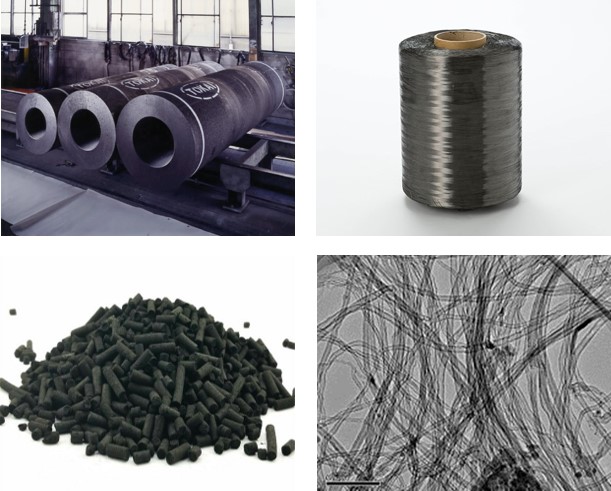
Various carbon forms. From top left clockwise: graphite electrodes, carbon fibers, carbon nanotubes (TEM image), and activated carbon powder
We believe carbon science and technology will play a pivotal role in manufacturing various devices, vehicles, and complex macroscale structures essential for the fourth industrial revolution, which will change in the way we live, work and relate to one another. In addition, there is a growing demand to develop versatile and functional carbon materials from sustainable resources and processes to prepare for energy and environmental issues in the near future. As members of Carbon Composite Materials Center at KIST Jeonbuk, in response to those need, we aim to estabilish our center's vision and strategy for carbon materials manufacturing technology, covering from precursor synthesis to manufacturing process and study on physical properties.
1. Development of novel carbon fiber manufacturing technology
Carbon fiber, invented by Joseph Swan for the use of a light bulb filament in 1860, has been considered as an ideal material for building a light-weight composite with heavy-duty performance for its well-known exceptional mechanical properties along with other attractive material properties including low density, high chemical resistance and high temperature endurance. It has been used in various applications such as automobile, aerospace, sports, and many other components.

A scheme summarizaing a history of carbon fiber research. [figure courtesy of Carbon, 2019, 142, 610.]
There are five steps for carbon fiber manufacturing: precursor synthesis, fiber spinning, stabilization, carbonization, and surface treatment. Among those processes, our group focuses on the thermal stabilization step in particular, which converts fusible carbon precursor fibers into infusible ones prior to the subsequent carbonization process by modifying the chemical structures of precursor molecules by atmospheric oxygen at the atomic level. This process is very important because thermostabilization process greatly contributes to a remarkable enhancement in yield and physical properties of high-performance carbon fibers. Even though the process conditions and duration of the stabilization vary depending on the type of precursor fiber, it is the longest step in carbon fiber industries because oxygen diffusion takes time to induce reaction.
Therefore, we are implementing highly efficient and novel methods to conventional thermostabilization process to reduce the process time and energy consumption, with a prospect of the significant reduction in the production cost of carbon fibers without deterioration of physicochemical properties.
Acceleration of the thermal stabilization process by plasma treatment
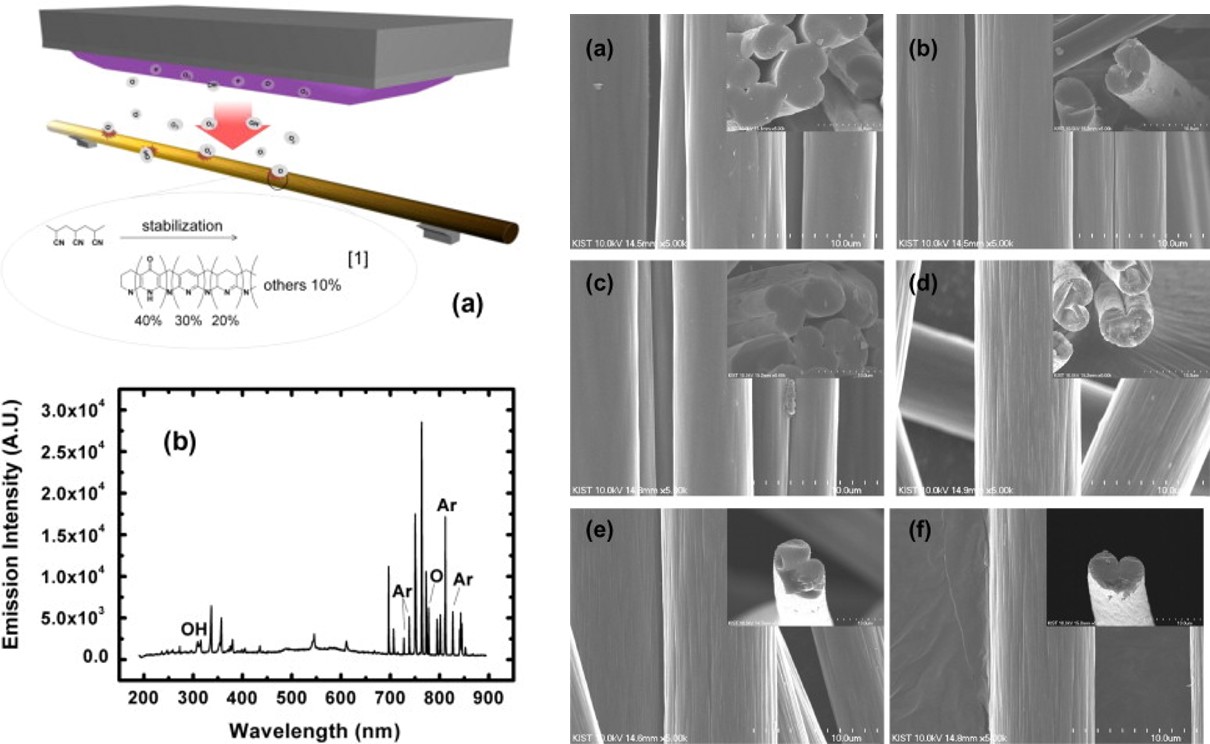
Carbon fibers from plasma-treated PAN fibers. [figure courtesy of Carbon, 2013, 55, 361.]
Irradiation techniques for rapid stabilization of carbon fibers
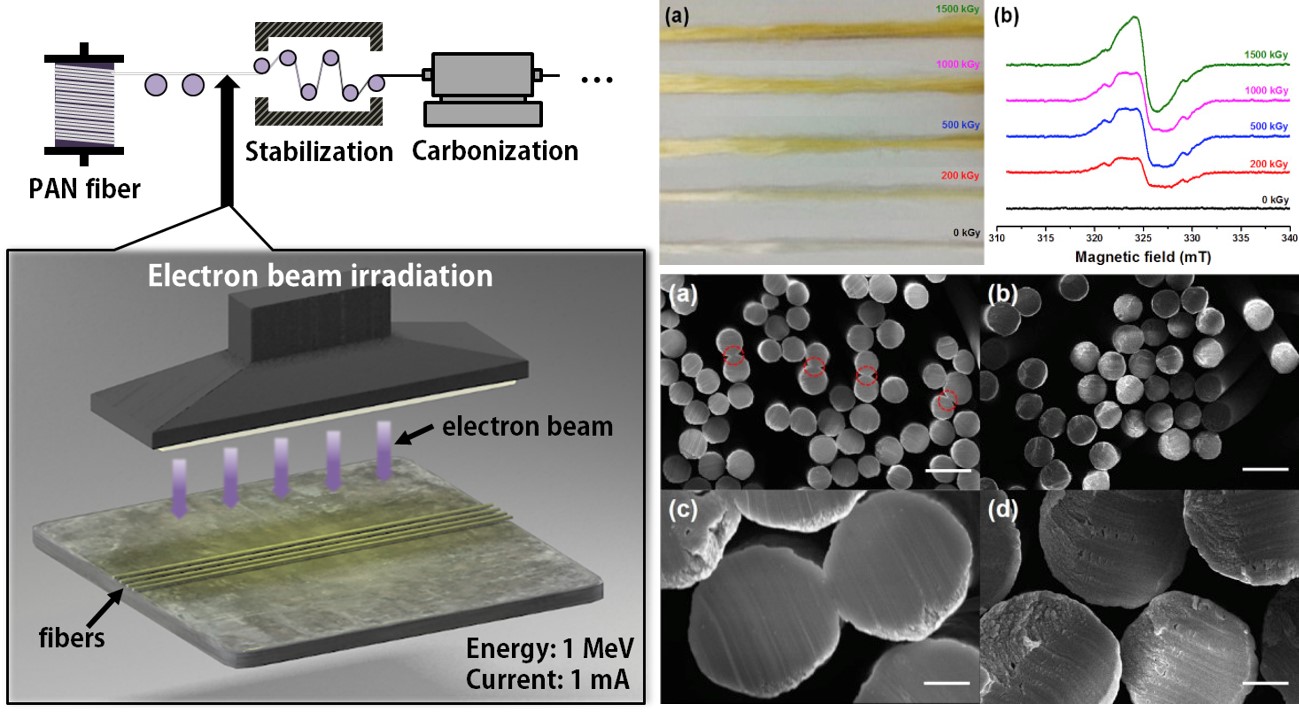
Carbon fibers from textile-grade PAN fibers irradiated by electron beam. [figure courtesy of Carbon, 2017, 118, 106.]
2. Carbon fibers with high remarkable mechanical and physical properties
Carbon fibers, the general term for fibrous carbon material, are mainly formed from three precursors, polyacrylonitrile (PAN), rayon, and pitch, which are converted to fibers via fiber spinning, heat treatments, such as stabilization, carbonization and graphitization processes. Among those processes, stabilization can carbonization are key steps to determine considerable mechanical properties of resulting carbon fibers because the ordered structures consisting of polyaromatic carbon layers are formed during these periods. For example, without an uniform diffusion of atmospheric oxygen through the fiber precursor, uneven stabilization or rapid oxidation can yield the final carbon fiber possessing poor properties. In addition, a properly designed carbonization protocol can control the transformation of organic substances to carbon fibers through carbonaceous intermediates, effectively eliminating heteroatoms (H, N, O, and S) and enhancing the degree of structural order in resulting carbon fibers.

A schematic illustration of carbon fiber preparation process
Hence, the stabilization and carbonization method and condition can be considered as critical variables for the development of a well-organized graphitic carbon structure and the reduction of surface and internal defects in the carbon fibers. Our group performs a systematic and mechanicstic study on analyzing and optimizing the stabilization and carbonization process by varying heating conditions such as a heating rate, intial and final temperatures. In addition, various characterization tools were employed to identify the underlying relationship between the evolution of fibers' inner structures and their physicomechanical properties.
Mechanistic study of carbonized pitch fiber with different carbonization temperature
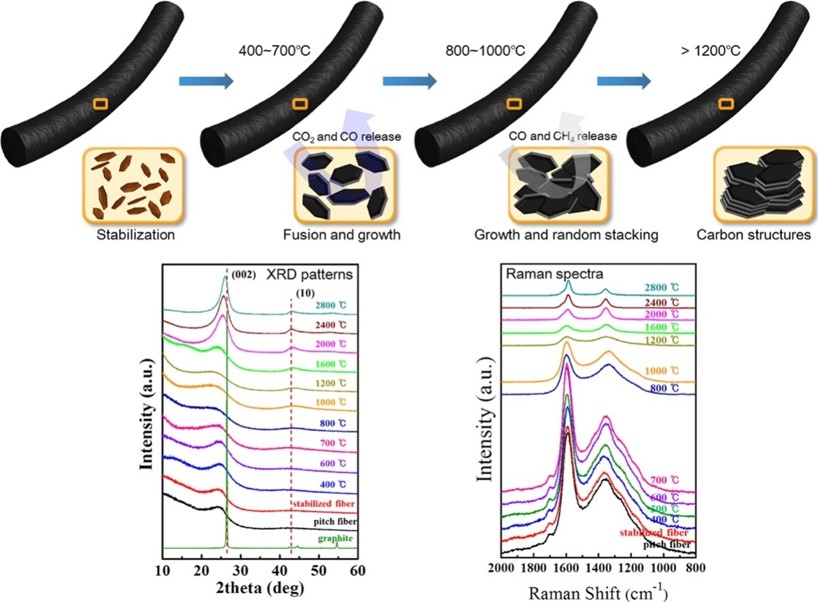
Evolution of carbon structures in the pitch fiber at different carbonization temperature [figure courtesy of J. Anal. Appl. Phys. 2018, 136, 153.]
Relationship between stabilization variables on mechanical properties of pitch-based carbon fibers
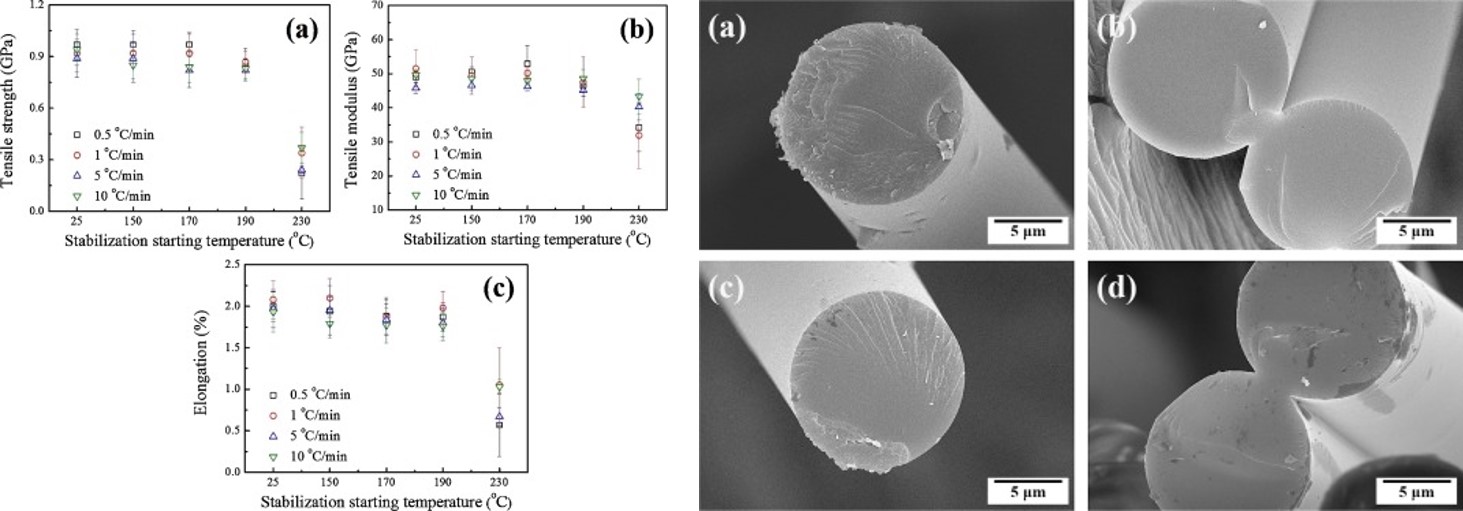
Mechanical properties and SEM images of pitch-based carbon fibers with different stabilization heating rate [figure courtesy of J. Ind. Eng. Chem. 2018, 58, 349.]
Opto-thermal technique for measuring thermal conductivity of carbon fibers

Thermal conductivities of carbon fibers obtained by Raman spectroscopy [figure courtesy of J. Ind. Eng. Chem. 2019, 78, 137.]
3. Carbon materials derived from low-cost resources
Carbon fibers are generally manufactured via heat treatments such as stabilization and carbonization of precursor fibers using polyacrylonitrile (PAN), pitch, and rayon. Even though CFs boast exceptional mechanical properties over other structural materials, however, their use has been strictly limited to exotic applications, such as aircraft and military vehicles, because the production cost of carbon fibers is extremely high, almost 50% of which precursor cost constitutes. In other words, cutting down the precursor cost can be a straight-forward strategy to successfully reduce the total production cost. For example, the production of PAN fiber is responsible for 53% of the total cost for PAN-based carbon fibers. As a result, the main strategy to reduce the carbon fiber production cost has been focused on adopting low-cost precursor other than conventional PAN. A variety of researches have reported carbon fiber fabrication from acrylic precusors including textile PAN and pitch, a viscoelastic material derived from petroleum or coal tar.
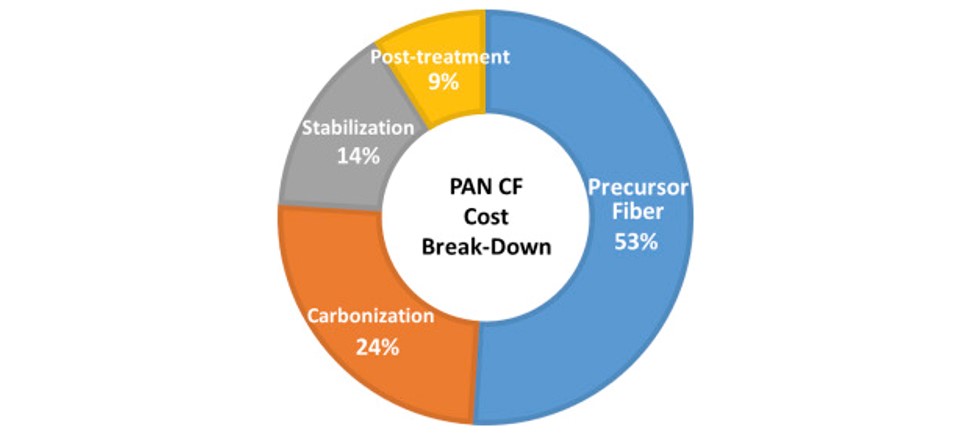
A chart presenting the cost analysis of PAN-based carbon fiber production. [figure courtesy of U.S. Department of Energy (2011)]
Our group studies on the fabrication of fibers from waste materials encompassing disposed plastic commodity products, poultry feather waste, and lignin, a substance considered as a waste product from paper industry. There is a growing concern about an ecological crisis associated with disposal and incineration of those garbages, and converting them into value-added materials, so-called upcycling, has garnered a great interest to effectively and extensively solve this environmental problem. For this purpose, we are carrying out the research to produce various carbon materials including carbon fibers and activated carbons from polyethylene waste, chicken feather meal, and chemically functionalized lignin.
Carbon materials converted from plastic wastes
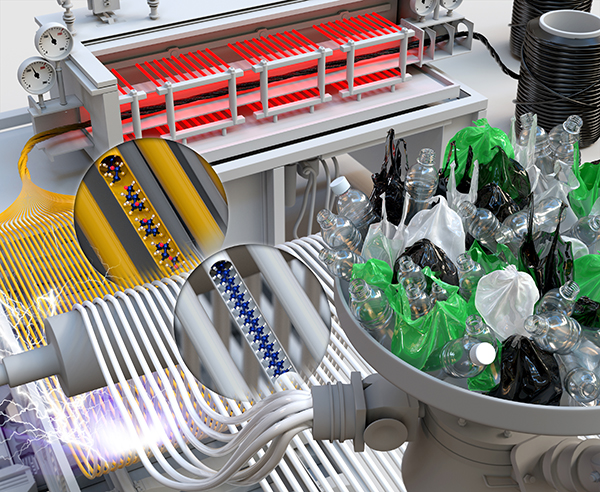
Illustrative figure describing the conversfion of plastic wastes into carbon fibers

High electric conductivity of carbon materials upcycled from LLDPE [figure courtesy of Chem. Mater. 2017, 29, 9518.]
Hierarchically mesoporous activated carbon obtained from carbonized chicken feather meal
Chemically functionalized lignin as a biorenewable feedstock for low-cost carbon fibers
4. Advanced functional carbon materials for energy applications
Diverse anode materials have been studied since the birth of lithium ion battery in the end of 1980s and early 1990s, but graphitic carbon is still the only commercially available product. Despite a drawback of their low theoretical maximum capacity (~372 mAh/g), carbon-based materials are preferred for the anode for their availability, low cost, performance, and stability. Hence, numerous studies on other advanced energy storage devices including lithium-sulfur battery, sodium-ion battery and fuel cell start with carbon materials as their anode material. Since the materials with high surface area and excellent conductivity enormously increases the specific capacity, cyclability and rate capability of material, our work aims to control the macro and microstructure of final carbonized materials to obtain optimized electrochemical features to be utilized in next-generation energy storage devices and fuel cells.
Carbon materials as an active materials for energy stroage devices

